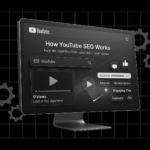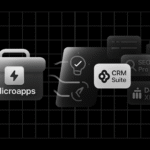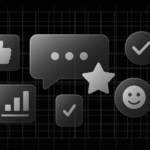If you’re an indie developer, no-code builder, or AI tool creator, you know that building the product is only half the battle. The real challenge? Learning how to market an AI tool effectively, especially if you’re aiming to get your first 100 users.
In this guide, we’ll walk you through a practical, step-by-step approach to how to market an AI tool, grow your user base from zero, turn your idea into a microapp, and lay the foundation for long-term, passive income as a developer.
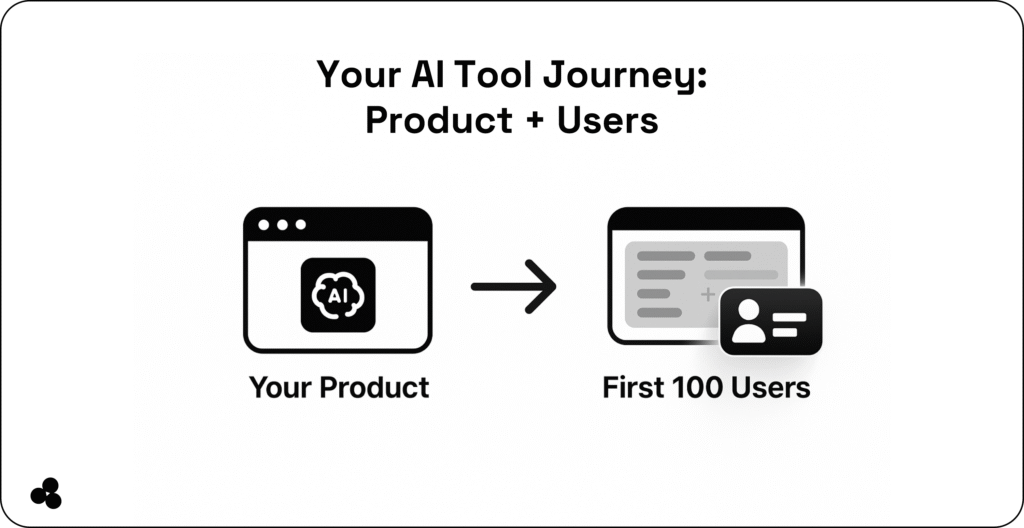
How to Market an AI Tool: Understanding Your Audience (Who Are They, Really?)
Before you market anything, you need to know who you’re talking to. One of the biggest reasons products fail isn’t because the idea was bad; it’s because the creator didn’t understand the audience they were building for.
Why Audience Clarity Matters
You have spent months building your AI-powered scheduling assistant for small businesses, only to realize that the people who want this feature are freelance consultants needing it for client meetings, not office managers juggling multiple employees.
That’s a costly mistake you could’ve avoided with proper audience research. Whether your goal is to monetize your web app or launch a microapp fast, clarity on your audience will give you three significant advantages:
- First, you’ll know what problems to solve.
- Secondly, you’ll be able to create a high-converting copy.
- Lastly, you’ll identify the best marketing channels to reach them.
To market an AI tool, you must first do your homework, following these steps:
Step 1: Create an Ideal Customer Profile (ICP)
Your ICP is a semi-functional representation of the person who will benefit the most from using your tool, and be specific.
An example of a bad ICP is “Anyone who needs AI,” instead, find a good ICP such as “Remote startup founders in North America who spend 5+ hours a week on email and would benefit from an AI email summarizer that integrates with Gmail.”
Then, include details in your ICP, such as demographics (age, gender, location, profession), psychographics (goals, frustrations, buying triggers), tech stack (the tools they currently use), and budget awareness (are they bootstrapped or funded?).
For example, if you’re building a no-code AI automation tool, your ICP might be:
“No-code creators aged 25-40 who build internal tools for small teams using Airtable and Zapier, who want to add AI functionality without touching code.”
Step 2: Join and Observe Communities
Next, start hanging out where your audience already spends time, for example, Reddit, Discord servers for AI startups, or Product Hunt, where you can see what your users like and dislike.
Spend a week simply reading and not selling to identify pain points, and start a swipe file to record everything you come across. You might notice that a lot of creators complain about OpenAI’s API limits or billing confusion, which can help you create a tool that simplifies API budgeting and cost tracking.
Step 3: Talk to Humans (Seriously)
Here is where many builders fall short, as they skip having conversations with people. We recommend aiming for 5-10 one-on-one interviews before launching your product. You can ask them the following questions:
- “Tell me about your current workflow. What’s frustrating?”
- “What tools are you using now? Why those?”
- “If this AI tool existed, would you use it? Why or why not?”
- “How would you expect to pay for this kind of solution?”
Tip: Record the call (with permission). You’ll get words and phrases you can later use in your landing pages, emails, and onboarding.
Step 4: Validate with Micro Surveys
If you don’t have time for the interview, you can build a lightweight survey using Google Forms and ask about:
- Their most significant challenges in [your tool’s category]
- What tools are they currently using
- Whether they’d be open to beta testing
You can then distribute your survey through your network, communities, and social channels to get responses.
👉 Make sure to check out our article on how to price your app to set a perfect price.
Build an Early Interest List (Pre-launch Strategies)
You want to create anticipation before launching your product. Create an early interest list to validate your idea, but also to provide a ready audience eager to try your product upon release.
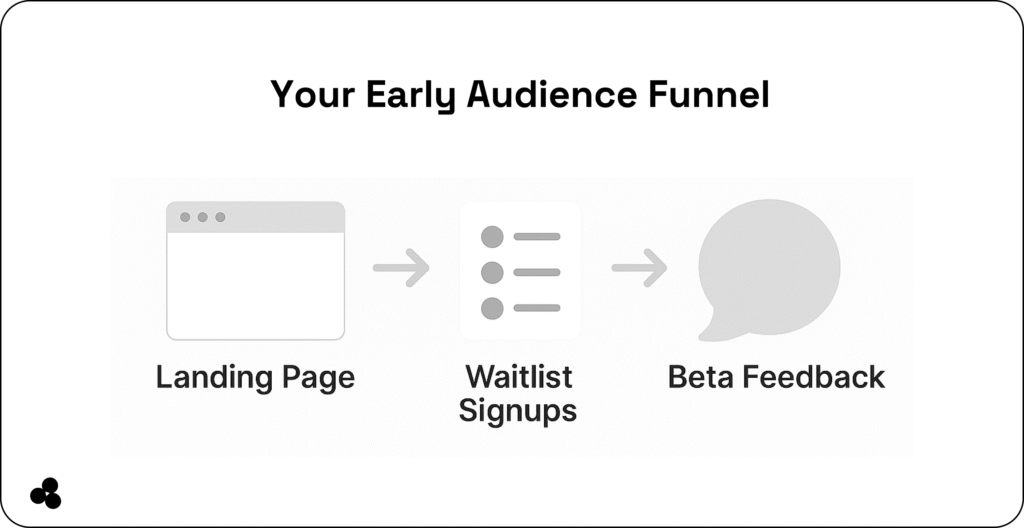
Develop a Compelling Landing Page
Utilize platforms like LaunchList and Webflow to design a compelling landing page. Clearly state the problem your AI tools solve and the value they will add to users, and include a call-to-action to join your waitlist.
Offer Incentives for Sign-ups
Encourage sign-ups by offering benefits such as early access, discounts, or premium features. For instance, you could provide beta access to the first 100 subscribers or offer a lifetime discount for early adopters.
Leverage Social Proof
Then display the number of people who have joined your waitlist to create a sense of urgency. Sharing your milestones, like “Join 500+ early adopters”, can motivate others to sign up.
Engage Through Content Marketing
Now, you can start a blog or a YouTube channel to share your content related to your AI tool niche. It will help position you as an authority and drive organic traffic to your landing page.
Utilize Email Marketing
Most importantly, always keep your waitlist engaged by sending them regular updates, sneak peeks, and behind-the-scenes content to maintain interest and build a relationship with potential users.
Leveraging Product Hunt & Beta Communities
To further gain exposure and attract early adopters, use platforms like Product Hunt and other beta communities. You can:
- Craft compelling Product Hunt listings with visuals, descriptions, and a personal founder’s note to keep your users engaged and responding to comments.
- Alternatively, you can list your product on platforms like Indie Hackers, BetaList, and relevant subreddits, allowing early adopters to try your new tools and provide feedback.
- Additionally, identify influencers or leaders in your niche and reach out to them for feedback or potential collaboration opportunities. With their endorsement, your product visibility can be significantly boosted.
- Then, use the feedback from those communities to refine your product further, demonstrating that you value their input and feedback.
Organic Marketing Tactics (SEO, Social, Content)
Did you know that sustainable growth often comes from organic channels? When you implement effective SEO strategies, engage on social media, and produce valuable content, it drives consistent traffic and user acquisition.
Optimize for SEO: Research keywords related to your niche to incorporate them into your website and content. You can use tools like Google Keyword Planner to identify high-traffic keywords.
Content Marketing: Regularly publish blog posts, tutorials, or case studies that address your target audience’s pain points. This not only improves SEO but also establishes your authority in the field.
Social Media Engagement: Share updates, behind-the-scenes looks, and valuable insights on platforms like X (Twitter), LinkedIn, and Reddit. Engaging with your audience builds a community around your product.
Collaborate with Other Creators: Partner with other developers or creators to co-create content, host webinars, or cross-promote each other’s products. This expands your reach and taps into new audiences.
👉 Check out our article on how you can make your performance review software here.
Measuring Success: Analytics & Iteration
Now that you’ve done the most on how to market an AI tool, tracking (KPIs) your progress will help you make informed decisions and refine your strategies for improved results. We recommend you establish clear metrics to measure your success, such as sign-ups, active users, retention rates, and conversion rates.
Then, implement tools like Google Analytics to monitor user behavior, track traffic sources, and pinpoint areas where users tend to drop off. Also, experiment with different headlines by conducting A/B testing. Experiment with different CTAs or onboarding processes to determine what works best for your audience.
Additionally, continue to gather user feedback through interviews, surveys, or feedback forms to make beta-driven improvements to your product. Lastly, keep refining your product and marketing strategies based on the insights gathered.

Ready to get started? Start building your audience on Microapp today. Launch a microapp with us now.





